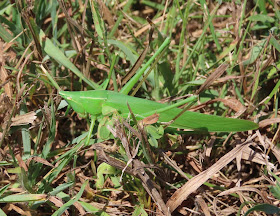Believe it or not, there is a mosquito species I look forward to seeing every year. You may think I'm crazy, but hear me out. There are at least three reasons to love elephant mosquitoes in the genus Toxorhynchites. They are pretty, beneficial in the larval stage, and do not bite as adults.
Elephant mosquitoes are also known as giant treehole mosquitoes, so you can sense a theme here. They are indeed large for mosquitoes, averaging about seven millimeters in body length. That does not include the mouthparts and antennae. Their long legs make them appear larger still. Why the name "elephant mosquito?" It may be a reference to the long, upcurved palps of the males, which suggest elephant tusks.
There is no denying the beauty of our single North American species, Toxorhynchites rutilus. They are iridescent blue and purple, with silver and gold highlights, and white tips on the hind legs. It seems that no one photo captures all the colors all at once. Despite their brilliance, they are surprisingly cryptic in the dimming light of dusk, when they are most active (though they are considered day-fliers).
As their other name indicates, elephant mosquitoes breed mostly in water-filled treeholes. The larval stage, at least in later instars, is predatory on other aquatic insects, including....wait for it....the larvae of other mosquitoes. Yes, you heard that correctly, they are a natural biological control of the mosquito species that pose a threat to human health. The larvae are reddish in color, with a short anal siphon (bearing the spiracle that permits intake of air at the water surface), and a broad, black head with strong mandibles. There are four larval instars, an instar being the interval between molts.
The adult elephant mosquito has a distinctive proboscis, bent strongly downward near the middle of its length. Instead of using their beaks to draw blood from other animals, elephant mosquitoes of both sexes feed only on flower nectar. As flower visitors, they are also pollinators of wildflowers. Some other species in the genus may also feed on fruit juices, and honeydew (the sugary liquid waste of aphids, scale insects, and various planthoppers).
Here in northeast Kansas, on the Missouri border, I have found Toxorhynchites rutilus only in late autumn, and only on the flowers of White Snakeroot. I have only seen them in our yard, in fact, but I am not usually exploring elsewhere as sunset approaches. The species ranges from the eastern half of Texas and Oklahoma diagonally northeast to southern Pennsylvania, Connecticut, and Delaware.
There are roughly eighty species of Toxorhynchites, occuring mostly in tropical regions around the globe. Due to their unique appetite for other mosquitoes, they have been employed as biological controls for container-breeding mosquitoes in Japan, southeast Asia, the Caribbean, and in some cities in the United States.
Are you a new fan of elephant mosquitoes yet? If not, please see the resources and links below for additional information on the biology of these remarkable flies. Mosquitoes, like most insects, and people, defy neat categorizing as "bad" or "good." Entomology is a great place to learn lessons like that.
Sources: Alomar, Abdullah A. and Barry W. Alto. 2022. "Elephant Mosquito Toxorhynchites rutilus Coquillett, 1896 (Insecta: Diptera: Culicidae)," Ask IFAS EENY-787/IN1380. University of Florida.
Coin, Patrick, et al. 2004. "Species Toxorhynchites rutilus - Elephant Mosquito," Bugguide.net
Donald, Claire L., Padet Siriyasatien, and Alain Kohl. 2020. "Toxorhynchites Species: A Review of Current Knowledge," Insects 11(11): 747.
McAlister, Erica. 2017. The Secret Life of Flies. Buffalo: Firefly Books. 248 pp.
Ricciuti, Ed. 2019. "Meet the Mosquito With a Big Appetite - for Other Mosquitoes," Entomology Today.



















